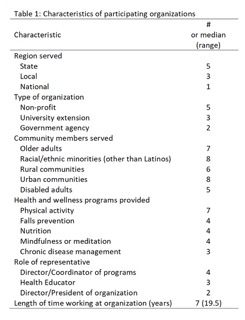Back
Poster Session D
Epidemiology, health policy and outcomes
Session: (1750–1786) Epidemiology and Public Health Poster III
1783: Exploring How and Why Organizations Identify, Adopt, Disseminate, and Sustain Evidence-based Programs for Latinos with Arthritis
Monday, November 14, 2022
1:00 PM – 3:00 PM Eastern Time
Location: Virtual Poster Hall
- MM
Marvin Albert Meza Jarquin, BA
UNC School of Medicine
Chapel Hill, NC, United States
Abstract Poster Presenter(s)
Marvin Albert Meza Jarquín1, Leigh Callahan2, Serena Weisner3, Kirsten Ambrose3 and Sandra Soto4, 1School of Medicine, University of North Carolina (UNC), Chapel Hill, NC, 2University of North Carolina Thurston Arthritis Research Center, Chapel Hill, NC, 3Thurston Arthritis Research Center, Chapel Hill, NC, 4Thurston Arthritis Research Center, UNC Division of Rheumatology, Allergy and Immunology, Chapel Hill, NC
Background/Purpose: Physical activity (PA) is effective in the self-management of arthritis. As such, several evidence-based programs aimed at supporting safe and meaningful PA have been developed, including Walk With Ease (WWE), a 6-week walking and behavior change intervention. The self-directed version of WWE has been translated into Spanish, Camine con Gusto (CCG). Unfortunately, few organizations have adopted and disseminated CCG to their Spanish-speaking community members. Guided by the Diffusion of Innovations Theory (DIF), the purpose of this study was to explore how organizations learn about, decide to adopt, disseminate, and sustain evidence-based programs like WWE/CCG.
Methods: This study used qualitative data from one-on-one interviews with representatives from organizations that serve or are interested in serving more Spanish-speaking Latinos. Organizations may or may not have already disseminated WWE and/or CCG and could serve communities at the local, state, or national level. A semi-structured interview guide was created to explore the 5 stages of the DIF: knowledge, persuasion, decision, implementation, and confirmation. Rapid qualitative analysis was used to examine themes and subthemes based on the DIF.
Results: Nine organizations were included in the study that served state (n=5), local (n=3), and national (n=1) communities. Five were non-profits, three were university extensions, and two were government agencies. We interviewed two Directors/Presidents, four Program Coordinators, and three Health Educators. The following themes emerged based on the DIF stages: 1) Knowledge: Organizations become aware of programs through their partnerships, funders, or government-created lists of evidence-based programs. 2) Persuasion/Decision: Organizations need to know if a program meets their community's needs, funding is available, additional resources are needed to start and run the program, and the program is evidence-based. 4) Implementation: Organizations typically pilot test a program to ensure its success before adopting it permanently. Several organizations have culturally adapted and/or modified programs to increase community uptake (e.g., adding one-on-one coaching or pedometers to WWE/CCG). 5) Confirmation: Primary reasons for maintaining a program were attendance and cost.
Conclusion: Findings show that CCG is well-suited for adoption by organizations because it is low-cost, brief, and evidence-based. To further expand its demand, Spanish-language program materials should be made ready "right off the shelf," success stories from other organizations should be marketed, and further research is needed to examine the cost-benefit analysis of adding health coaches and pedometers to the program.
 Characteristics of participating organizations
Characteristics of participating organizations
Disclosures: M. Meza Jarquín, None; L. Callahan, None; S. Weisner, None; K. Ambrose, None; S. Soto, None.
Background/Purpose: Physical activity (PA) is effective in the self-management of arthritis. As such, several evidence-based programs aimed at supporting safe and meaningful PA have been developed, including Walk With Ease (WWE), a 6-week walking and behavior change intervention. The self-directed version of WWE has been translated into Spanish, Camine con Gusto (CCG). Unfortunately, few organizations have adopted and disseminated CCG to their Spanish-speaking community members. Guided by the Diffusion of Innovations Theory (DIF), the purpose of this study was to explore how organizations learn about, decide to adopt, disseminate, and sustain evidence-based programs like WWE/CCG.
Methods: This study used qualitative data from one-on-one interviews with representatives from organizations that serve or are interested in serving more Spanish-speaking Latinos. Organizations may or may not have already disseminated WWE and/or CCG and could serve communities at the local, state, or national level. A semi-structured interview guide was created to explore the 5 stages of the DIF: knowledge, persuasion, decision, implementation, and confirmation. Rapid qualitative analysis was used to examine themes and subthemes based on the DIF.
Results: Nine organizations were included in the study that served state (n=5), local (n=3), and national (n=1) communities. Five were non-profits, three were university extensions, and two were government agencies. We interviewed two Directors/Presidents, four Program Coordinators, and three Health Educators. The following themes emerged based on the DIF stages: 1) Knowledge: Organizations become aware of programs through their partnerships, funders, or government-created lists of evidence-based programs. 2) Persuasion/Decision: Organizations need to know if a program meets their community's needs, funding is available, additional resources are needed to start and run the program, and the program is evidence-based. 4) Implementation: Organizations typically pilot test a program to ensure its success before adopting it permanently. Several organizations have culturally adapted and/or modified programs to increase community uptake (e.g., adding one-on-one coaching or pedometers to WWE/CCG). 5) Confirmation: Primary reasons for maintaining a program were attendance and cost.
Conclusion: Findings show that CCG is well-suited for adoption by organizations because it is low-cost, brief, and evidence-based. To further expand its demand, Spanish-language program materials should be made ready "right off the shelf," success stories from other organizations should be marketed, and further research is needed to examine the cost-benefit analysis of adding health coaches and pedometers to the program.
 Characteristics of participating organizations
Characteristics of participating organizationsDisclosures: M. Meza Jarquín, None; L. Callahan, None; S. Weisner, None; K. Ambrose, None; S. Soto, None.

